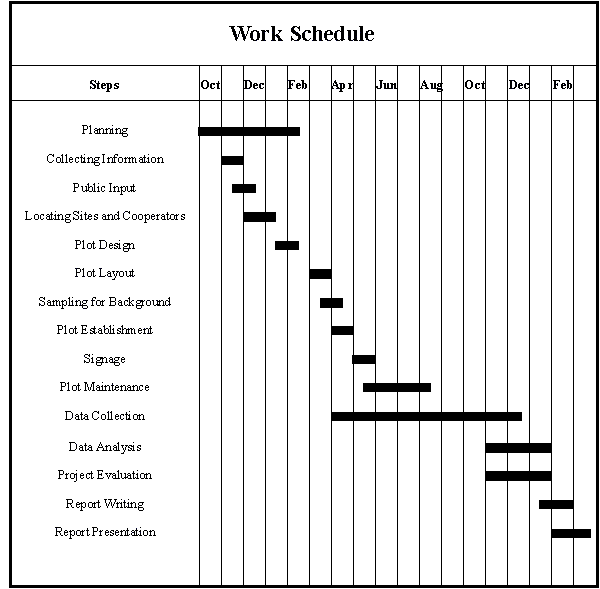| | When planning your field experiment, you must consider lead time, objectives, benefits, alternatives, budgets, cooperators and work schedules.
Lead time
Start planning a half to a full year before the beginning of your first field season. With adequate lead time, you can:
- introduce the proposed project to the community well before the start-up date. This allows the people involved to evaluate the project. It also allows you to gauge interest in the project and identify potential cooperators based on expressed interest.
- choose the best cooperators and incorporate their ideas into the project.
- investigate and characterize potential field plot sites.
- give any other agencies involved in the project the time they need to assess the study and allocate resources to it.
Objectives
Define the project's objectives early in the planning stage. The objectives should be:
- clearly defined.
- obtainable with the existing resources.
- obtainable within the project's time frame.
Determine what information the project should provide and if this is the information needed.
Benefits
To determine a project's potential benefits, consider the following aspects:
- the project's practical significance to local farmers.
- its potential economic benefits to farmers.
- the group of people who could benefit from the technology.
- the number of local operations that could be influenced by the study.
- the amount of interest expressed by local people.
- the current use of the technology by farmers in other areas.
Alternatives
Consider all your options. Would a tour to another area be as effective as conducting a local field experiment? Is the information that would come out of the project already be available, for example, from research reports, similar projects in other areas, experts (farmers, researchers, extension specialists) from other areas? If the readily available information could be implemented without local tests or adaptation, you may not need to go to the time and expense of conducting an applied research experiment. A simple demonstration might be more appropriate.
Budgets
Make sure your planned budget does not exceed the available funds. Keep in mind payment schedules, potential delays in receiving funds, and hold-back of final payments. List all items contributed by the cooperators and sponsors to ensure a clear understanding of the total resources going into the project.
Prepare realistic estimates of expenses. Be sure to consider all the costs involved, including:
- rental of land and equipment.
- materials, services, laboratory analyses, travel, manpower and tours.
- inflation, if it is a long-term project.
- contingencies, perhaps 10%.
- incidentals (e.g., long distance telephone charges, office supplies, film, camera, and audiovisual equipment).
- employee benefits (CPP, UIC, Worker's Compensation). insurance requirements for transporting equipment, highway permits, operator coverage, liability coverage, etc.
- awareness (signs, local newspaper advertisements and mailings).
Cooperators
Seek out potential cooperators months in advance. Contact more people than needed in case some are unable to participate. Involve potential cooperators in the planning stage. They need to know what will be expected of them so they can assess whether they can handle the project and if they wish to be involved.
Characteristics to look for in farmer cooperators include:
- a genuine interest in the project topic.
- a commitment to seeing the project through to completion.
- respected in the farm community.
- enjoyment of receiving visitors to the farm and discussing the project.
- sufficiently outgoing to feel comfortable with the attention focused on the farm operation and the field experiment.
- the ability to cope with both known and unforeseen inconveniences.
- the ability to communicate and willingness to speak in front of a group.
- the time and equipment necessary to carry out the project.
- an unbiased record keeper. The cooperator's recorded observations are often valuable when it comes to explaining unexpected results.
Other possible cooperators are agribusiness personnel, university or government researchers and extension specialists, commodity marketing groups and producer groups.
Once you have selected your cooperators, obtain written confirmation of their willingness to participate and sign a lease agreement if required. If possible, bring all cooperators together for a meeting before start up.
Work schedules
Work schedules can be effective tools in both project planning and implementation (Figure 1). A successful field experiment requires a major commitment during the busiest part of the cropping season. Be sure your schedule includes time for other major commitments outside of the project.

Figure 1 Sample work schedule for an applied research or demonstration project
Statistics
Statistical design and analysis are an integral part of collecting data and comparing treatments for applied research projects. Statistical analysis allows you to objectively compare treatments and decide if one treatment has a real advantage over another. Various statistical designs and analyses are discussed in the following section and the printed copy of this publication.
Contact Tom Goddard, Soil Conservation Specialist, Alberta Agriculture and Food. |
|